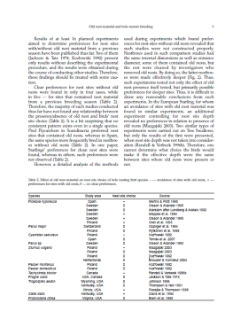- Wyszukaj w całym Repozytorium
- Piśmiennictwo i mapy
- Archeologia
- Baza Młynów
- Nauki przyrodnicze
Wyszukiwanie zaawansowane
Wyszukiwanie zaawansowane
Wyszukiwanie zaawansowane
Wyszukiwanie zaawansowane
Wyszukiwanie zaawansowane

Obiekt
Tytuł: Survival Rates of Young Magpies Pica pica in a Mountain Population of Eastern Spain
Twórca:
Ponz Miranda, Adrián ; Gil-Delgado Alberti, José Antonio ; López Iborra, Germán M
Data wydania/powstania:
Typ zasobu:
Inny tytuł:
Przeżywalność młodych srok w populacji z górskich obszarów wschodniej Hiszpanii ; Survival rates of young magpies
Współtwórca:
Museum and Institute of Zoology, Polish Academy of Sciences
Wydawca:
Natura Optima Dux Foundation ; Museum and Institute of Zoology, Polish Academy of Sciences
Miejsce wydania:
Opis:
Typ obiektu:
Abstrakt:
The aim of this study was to estimate the survival of young Magpies between fledging and the next breeding season and to identify some of the factors affecting it. A total of 50 nestlings were colour-ringed in two breeding seasons in the valley of the Pitarque River (Teruel, E Spain), and were monitored weekly until May of the following year. 59 nestlings were also colour-ringed in two nearby localities (4–5 km) to detect possible dispersal to and from our study area. Mark-recapture analyses were used to estimate weekly survival, which was assumed to be constant for periods of four weeks in order to reduce the number of parameters. Models with the effect of time, age class, season and year were fitted, and the best models were selected using quasi-likelihood Akaike's Information Criterion adjusted for small sample sizes (QAICC???). The best three models included seasonal variation in survival, and the second and third models also selected the effect of age class. The seasonal variation in the survival of young Magpies exhibited two critical moments: firstly, on becoming independent of the parent birds (August—September), and secondly, when individuals abandoned the communal roost and started to establish their own territories (February—March). The weight of 14-day-old nestlings positively affected survival until 4 and 6 months after leaving the nest. No evidence for dispersal was found; this supports the view that survival does indeed decrease in the cited periods, possibly because of the increased risk of predation.
Czasopismo/Seria/cykl:
Tom:
Zeszyt:
Strona pocz.:
Strona końc.:
Szczegółowy typ zasobu:
Format:
Identyfikator zasobu:
oai:rcin.org.pl:55634 ; 10.3161/068.042.0114
Źródło:
MiIZ PAN, sygn. P.4568 ; MiIZ PAN, sygn. P.257 ; kliknij tutaj, żeby przejść
Język:
Język streszczenia:
Prawa:
Prawa zastrzeżone - dostęp nieograniczony
Zasady wykorzystania:
Digitalizacja:
Muzeum i Instytut Zoologii Polskiej Akademii Nauk
Lokalizacja oryginału:
Biblioteka Muzeum i Instytutu Zoologii PAN
Dostęp:
Kolekcje, do których przypisany jest obiekt:
- Repozytorium Cyfrowe Instytutów Naukowych > Kolekcje Partnerów > Muzeum i Instytut Zoologii PAN > Czasopisma
- Repozytorium Cyfrowe Instytutów Naukowych > Kolekcje Partnerów > Muzeum i Instytut Zoologii PAN > Wydawnictwa MiIZ PAN > Acta Ornithologica
- Repozytorium Cyfrowe Instytutów Naukowych > Piśmiennictwo > Czasopisma/Artykuły
Data ostatniej modyfikacji:
2 paź 2020
Data dodania obiektu:
29 lip 2015
Liczba pobrań / odtworzeń:
23
Wszystkie dostępne wersje tego obiektu:
https://rcin.org.pl./publication/75714
Wyświetl opis w formacie RDF:
Wyświetl opis w formacie RDFa:
Wyświetl opis w formacie OAI-PMH:
Obiekty Podobne
Bokotej, Andrìj Andrìjovič (1966– )
Dombrowski, Andrzej
Witt, Klaus
Luniak, Maciej (1936– ) Kozłowski, Paweł (1961– ) Nowicki, Wiesław
Parrott, David
Górski, Wojciech (1946–2001) Kotlarz, Bogdan
Eguchi, Kazuhiro Takeishi, Masayoshi

 INSTYTUT ARCHEOLOGII I ETNOLOGII POLSKIEJ AKADEMII NAUK
INSTYTUT ARCHEOLOGII I ETNOLOGII POLSKIEJ AKADEMII NAUK
 INSTYTUT BADAŃ LITERACKICH POLSKIEJ AKADEMII NAUK
INSTYTUT BADAŃ LITERACKICH POLSKIEJ AKADEMII NAUK
 INSTYTUT BADAWCZY LEŚNICTWA
INSTYTUT BADAWCZY LEŚNICTWA
 INSTYTUT BIOLOGII DOŚWIADCZALNEJ IM. MARCELEGO NENCKIEGO POLSKIEJ AKADEMII NAUK
INSTYTUT BIOLOGII DOŚWIADCZALNEJ IM. MARCELEGO NENCKIEGO POLSKIEJ AKADEMII NAUK
 INSTYTUT BIOLOGII SSAKÓW POLSKIEJ AKADEMII NAUK
INSTYTUT BIOLOGII SSAKÓW POLSKIEJ AKADEMII NAUK
 INSTYTUT CHEMII FIZYCZNEJ PAN
INSTYTUT CHEMII FIZYCZNEJ PAN
 INSTYTUT CHEMII ORGANICZNEJ PAN
INSTYTUT CHEMII ORGANICZNEJ PAN
 INSTYTUT FILOZOFII I SOCJOLOGII PAN
INSTYTUT FILOZOFII I SOCJOLOGII PAN
 INSTYTUT GEOGRAFII I PRZESTRZENNEGO ZAGOSPODAROWANIA PAN
INSTYTUT GEOGRAFII I PRZESTRZENNEGO ZAGOSPODAROWANIA PAN
 INSTYTUT HISTORII im. TADEUSZA MANTEUFFLA POLSKIEJ AKADEMII NAUK
INSTYTUT HISTORII im. TADEUSZA MANTEUFFLA POLSKIEJ AKADEMII NAUK
 INSTYTUT JĘZYKA POLSKIEGO POLSKIEJ AKADEMII NAUK
INSTYTUT JĘZYKA POLSKIEGO POLSKIEJ AKADEMII NAUK
 INSTYTUT MATEMATYCZNY PAN
INSTYTUT MATEMATYCZNY PAN
 INSTYTUT MEDYCYNY DOŚWIADCZALNEJ I KLINICZNEJ IM.MIROSŁAWA MOSSAKOWSKIEGO POLSKIEJ AKADEMII NAUK
INSTYTUT MEDYCYNY DOŚWIADCZALNEJ I KLINICZNEJ IM.MIROSŁAWA MOSSAKOWSKIEGO POLSKIEJ AKADEMII NAUK
 INSTYTUT PODSTAWOWYCH PROBLEMÓW TECHNIKI PAN
INSTYTUT PODSTAWOWYCH PROBLEMÓW TECHNIKI PAN
 INSTYTUT SLAWISTYKI PAN
INSTYTUT SLAWISTYKI PAN
 SIEĆ BADAWCZA ŁUKASIEWICZ - INSTYTUT TECHNOLOGII MATERIAŁÓW ELEKTRONICZNYCH
SIEĆ BADAWCZA ŁUKASIEWICZ - INSTYTUT TECHNOLOGII MATERIAŁÓW ELEKTRONICZNYCH
 MUZEUM I INSTYTUT ZOOLOGII POLSKIEJ AKADEMII NAUK
MUZEUM I INSTYTUT ZOOLOGII POLSKIEJ AKADEMII NAUK
 INSTYTUT BADAŃ SYSTEMOWYCH PAN
INSTYTUT BADAŃ SYSTEMOWYCH PAN
 INSTYTUT BOTANIKI IM. WŁADYSŁAWA SZAFERA POLSKIEJ AKADEMII NAUK
INSTYTUT BOTANIKI IM. WŁADYSŁAWA SZAFERA POLSKIEJ AKADEMII NAUK


































